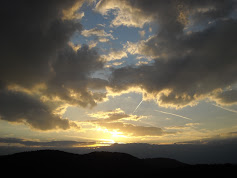EXTRA UPDATE!
Jennifer Wadkins, the landowner of the property, sent an e-mail to me saying they had dug out the depression and the depression is, in fact, a spring! Compare to the photo of the depression below before they dug it out! She invites your opinion!
We were told by the landowners that the pointer tree indicates the general direction of a spring-fed pond about a quarter mile away. The "Y" tree standing nearby (we've come to believe that "Y" trees often indicate the location of a spring) seems to confirm that these trees were marking the location of or direction to a good spring of fresh water. However, we also noticed other trees on the surrounding hillside that had obviously been altered by some weather event - either an ice storm or tornadic event which makes us skeptical about whether or not these trees are authentic Native-American marker trees at all. A depression that appears to have once been a spring lies within yards of the "Y" tree so that lends credibility to the theory that these trees are actually man-made markers (photo of depression below).
At EIC, we
want to believe that these trees we are finding along known early roads
and trails are actually living artifacts from our Native-American
forefathers but we are not convinced they are. We hope one day we can
either confirm them as Native-made or dismiss them as manipulated by
natural events.
Later
tonight, I will update this post with an example of a tree we found
along the trail we believe was an ancient section of an old Indian Trace
which stands beside West Rocky Bayou near Cooper Valley The example
looked promising from afar and was one that excited us as we have made
several predictions that have come true about finding bent trees along
this route. There was great disappointment, however, when we discovered
the tree was an old Sweet Gum and could not have been fashioned by the
hand of any Native American marking a trail because of the relatively
short life-span of the species.
UPDATE!
As promised, these are the photos of the Sweet Gum tree on Rocky Bayou. This tree has all the right things going for it to qualify as a thong tree except for its species. It has the right shape,the hip, the nose and is pointing almost directly at a gushing spring on the opposite bank of the creek, Nonetheless,it's a relatively fast-growing tree and is likely no more than fifty years old.






































No comments:
Post a Comment